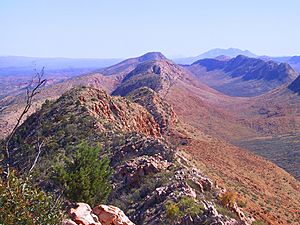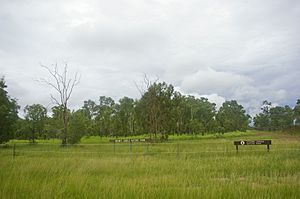Protected areas of the Northern Territory facts for kids
The protected areas of the Northern Territory are special places in Australia's Northern Territory. These areas are looked after by different groups, including the Northern Territory government, the Australian government, and private groups. They cover a huge area – about 335,527 square kilometres. That's almost a quarter of the entire Northern Territory! These protected areas help keep nature safe, including plants, animals, and important historical sites.
Contents
Why We Have Protected Areas
Protected areas are like giant nature reserves. They are set up to:
- Keep unique plants and animals safe from harm.
- Protect important natural places, like deserts, coastlines, and forests.
- Look after places that are special to Indigenous Australians.
- Preserve historical sites and cultural heritage.
- Give people places to enjoy nature, like hiking, camping, and wildlife spotting.
Who Looks After These Areas?
Different groups manage these protected areas. As of 2018, the Parks and Wildlife Commission of the Northern Territory looked after 86 parks and reserves. These covered over 5,000 square kilometres.
The Australian government also manages some important areas. In 2016, they looked after two large national parks and 15 Indigenous Protected Areas. Indigenous Protected Areas are managed by Indigenous communities, using their traditional knowledge to care for the land. These areas are very important and cover a massive 260,662 square kilometres.
There are also some private protected areas. These are owned and managed by non-government groups, often for conservation.
Northern Territory Government Protected Areas
The Northern Territory government manages many different types of protected areas. Each type has a special purpose.
Coastal Reserves
These areas protect the beautiful coastlines of the Northern Territory. They are important for marine life and coastal plants.
Conservation Areas
Conservation areas are set aside to protect specific natural features or wildlife habitats.
- Adelaide River Foreshore
- Douglas River / Daly River Esplanade
Conservation Covenants
A conservation covenant is a special agreement. Landowners agree to protect their land for conservation, even if they sell it later.
- Lake Woods
- Newry Station Gouldian Finch
Conservation Reserves
These reserves protect a wide range of natural environments, from unique rock formations to important wetlands.
- Black Jungle/Lambells Lagoon
- Fogg Dam (famous for its birdlife)
- Henbury Meteorites (where meteorites hit the Earth)
- Karlu Karlu / Devils Marbles (large, round granite boulders)
- Rainbow Valley (known for its colourful sandstone cliffs)
- Tnorala (Gosse Bluff) (a huge ancient impact crater)
Historical Reserves
Historical reserves protect places that are important to the history of the Northern Territory.
- Alice Springs Telegraph Station (an old telegraph station)
- Arltunga (site of the first gold rush in the NT)
- Chambers Pillar (a tall sandstone pillar, important to early explorers)
Hunting Reserves
These are areas where hunting might be allowed under strict rules, often to manage animal populations.
Marine Parks
Marine parks protect parts of the ocean and coastline. They are important for sea creatures and their homes.
- Garig Gunak Barlu
- Limmen Bight
National Parks
National parks are large, important areas that protect natural beauty and wildlife. They are often popular for visitors.
- Finke Gorge (home to ancient palm trees)
- Garig Gunak Barlu (the only national park in the NT that includes a marine park)
- Litchfield (famous for its waterfalls and swimming holes)
- Nitmiluk (known for its stunning gorges)
- Watarrka (home to Kings Canyon)
- West MacDonnell (features beautiful gorges and waterholes)
Nature Parks
Nature parks are smaller than national parks but still protect important natural areas. They are often closer to towns and easy to visit.
- Berry Springs (a popular swimming spot)
- Cutta Cutta Caves (limestone caves with stalactites and stalagmites)
- Holmes Jungle (a monsoon forest right near Darwin)
- Howard Springs (another popular swimming and picnic area)
Other Places Managed by NT Government
- Alice Springs Desert Park (shows off the plants and animals of the desert)
- George Brown Darwin Botanic Gardens (a beautiful garden in Darwin)
- Territory Wildlife Park (a zoo-like park where you can see NT animals)
Australian Government Protected Areas
The Australian government also manages some very important protected areas, often working with Indigenous communities.
Indigenous Protected Areas

These areas are managed by Indigenous Australians. They combine traditional knowledge with modern conservation methods to protect their ancestral lands.
- Angas Downs
- Dhimurru
- Warddeken
National Parks (Australian Government)
These are two of Australia's most famous national parks. They are managed by the Australian government, often in partnership with Indigenous land owners.
- Kakadu (a huge park famous for its wildlife, wetlands, and ancient rock art)
- Uluru-Kata Tjuta (home to the iconic Uluru and Kata Tjuta rock formations)
Private Protected Areas
Some private groups also own and manage land for conservation. The Australian Wildlife Conservancy is one such group. They create sanctuaries to protect endangered species and their habitats.
Images for kids
-
Rock carvings at the Ewaninga Rock Carvings Conservation Reserve




